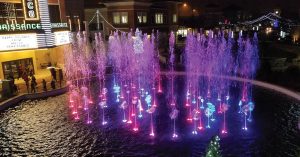— Interview with Tom Real —
How restaurants and retail stores can capitalize on the post-pandemic revival.
Although brick-and-mortar stores and restaurants were among the real estate sectors that suffered the most during the pandemic, these sectors also came roaring back as the crisis subsided. Owners of retail and restaurant properties are now looking for enticing amenities and engaging experiences that will pique investor and customer interest. We spoke with Tom Real, vice president of engineering and preconstruction at OTL, a leader in water features, rockwork and themed environments, about the types of assets and amenities that will attract retail and restaurant investors and patrons in the coming years, as well as how owners can meet their sustainability and cost-control goals.
R&R: As talk of a recession continues, what types of stores and restaurants will retail investors be eyeing?
Tom Real: Recession or not, retail investors are focused on shopping centers with consistently strong sales figures and steady, active foot traffic. As digital shopping continues to gain ground, stores that offer customers superior service and unique experience that cannot be achieved through online shopping will increasingly drive foot traffic and “hang time,” boosting sales. Restaurants are a key element in these centers as they invite people to extend their length of stay, which can lead to additional purchases. In fact, enjoying a meal at a restaurant is one of the activities we all missed the most during the pandemic, so now is the time to capitalize on customers’ appetite for dining out. With inflation causing food and operating costs to rise, the importance of providing a compelling menu, top-level service and a desirable environment cannot be overemphasized.
 We have seen the incredible ability of water features to enhance the appeal and elevate the value of retail centers for patrons, tenants, restaurateurs and investors. Water features — whether they are beautifully designed architectural fountains, show fountains with breathtaking programmed displays or naturalistic amenities such as the centerpiece our firm delivered at City Creek Center in Salt Lake City — can yield tremendous payoff for retail investors for many years after the initial installation.
We have seen the incredible ability of water features to enhance the appeal and elevate the value of retail centers for patrons, tenants, restaurateurs and investors. Water features — whether they are beautifully designed architectural fountains, show fountains with breathtaking programmed displays or naturalistic amenities such as the centerpiece our firm delivered at City Creek Center in Salt Lake City — can yield tremendous payoff for retail investors for many years after the initial installation.
R&R: What kinds of amenities will shoppers and diners be seeking going forward?
Real: The ability to gather safely was one of the chief criteria for public spaces during the pandemic. As a result, the popularity of outdoor dining areas grew significantly and have remained an important part of restaurant design — particularly in markets with mild weather year-round. Our company has also seen restaurants in retail centers request to be located near the fountains we design and build to enhance the outdoor atmosphere for their diners.
 In addition, amenities that provide a space for people to gather or rest during shopping trips or offer some form of entertainment are highly appealing to visitors. An example of this is the magnificent architectural fountain we designed and built at 2nd & PCH, a lifestyle center in Long Beach, California, developed by CenterCal Properties. The fountain’s centerpiece is a unique spherical sculpture created by artist Ivan McLean, and its exterior features a bespoke glass mosaic tile. Shoppers often take selfies in front of this water feature to share on social media.
In addition, amenities that provide a space for people to gather or rest during shopping trips or offer some form of entertainment are highly appealing to visitors. An example of this is the magnificent architectural fountain we designed and built at 2nd & PCH, a lifestyle center in Long Beach, California, developed by CenterCal Properties. The fountain’s centerpiece is a unique spherical sculpture created by artist Ivan McLean, and its exterior features a bespoke glass mosaic tile. Shoppers often take selfies in front of this water feature to share on social media.
Amenities like this enable the properties in which they are located to become destinations for people near and far.
R&R: How do these amenities match with the growing push for sustainability initiatives?
Real: Sustainability has become a growing focus for retail and restaurant owners as customers and investors have shown a preference for sustainability-minded businesses. Interestingly, even though water features obviously use water to function, these amenities can help retail stakeholders reach their sustainability goals in several ways.
 Water conservation is one of the main benefits of fountains because they can operate with recycled water and can incorporate sustainable sources for replenishment such as in rainwater harvesting, HVAC condensate, greywater (recycled from retail property systems such as sinks and other non-sewage usage) and municipal recycled water. Nearly every water feature our company builds is engineered to recirculate water and promote water conservation in a meaningful way.
Water conservation is one of the main benefits of fountains because they can operate with recycled water and can incorporate sustainable sources for replenishment such as in rainwater harvesting, HVAC condensate, greywater (recycled from retail property systems such as sinks and other non-sewage usage) and municipal recycled water. Nearly every water feature our company builds is engineered to recirculate water and promote water conservation in a meaningful way.
Another aspect to fountains that facilitates sustainability in retail and restaurant settings is that these amenities can be controlled remotely through modern-day technology, allowing the system to be shut down immediately without a property manager on site. The controls, which can be tied into building-management systems, can also detect leaks and alert owners and facility managers, preventing water waste and potential property damage.
R&R: How can retail and restaurant owners control costs as they focus on drawing in shoppers and diners?
Real: Retail and restaurant stakeholders can absolutely manage costs while delivering an attractive setting for their customers.
 By installing amenities like fountains, owners can offer beautiful and entertaining central gathering spaces that last for years with proper regular maintenance, minimizing downtime and positively impacting the bottom line.
By installing amenities like fountains, owners can offer beautiful and entertaining central gathering spaces that last for years with proper regular maintenance, minimizing downtime and positively impacting the bottom line.
In addition to helping save money, water features encourage visitors to relax and de-stress from their daily lives, giving them another reason to return to their favorite retail center or restaurant time and again.
— Tom Real is the vice president of engineering and preconstruction for Outside the Lines, Inc., a design-build themed construction company that specializes in creating one-of-a-kind rockwork, water features and themed environments for retail entertainment, hospitality, gaming and golf properties around the globe. More information is available at www.otl-inc.com.

